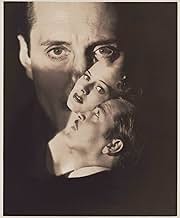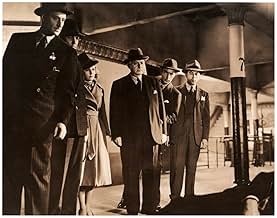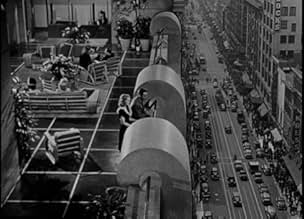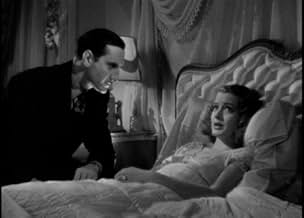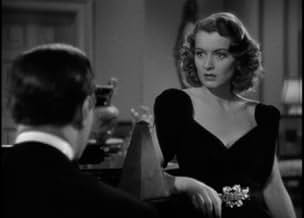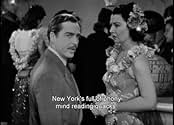Aggiungi una trama nella tua linguaA crazed physician marries a wealthy women and, with the help of his demented assistant, murders them for their money.A crazed physician marries a wealthy women and, with the help of his demented assistant, murders them for their money.A crazed physician marries a wealthy women and, with the help of his demented assistant, murders them for their money.
- Regia
- Sceneggiatura
- Star
Barbara Jo Allen
- Louise Watkins
- (as Barbara Allen [Vera Vague])
Bobby Barber
- Bald Man in Library
- (non citato nei titoli originali)
William 'Billy' Benedict
- Mickey Barnes - Copy Boy
- (non citato nei titoli originali)
George Chandler
- Elevator Operator
- (non citato nei titoli originali)
Edward Earle
- Librarian
- (non citato nei titoli originali)
Chuck Hamilton
- Police Officer at Train Station
- (non citato nei titoli originali)
Sam Harris
- Passerby
- (non citato nei titoli originali)
Harry Hayden
- Ticket Clerk
- (non citato nei titoli originali)
Douglas Kennedy
- Hotel Clerk
- (non citato nei titoli originali)
Settar Körmükçü
- Dr. David Profesor
- (non citato nei titoli originali)
John Laing
- Intern
- (non citato nei titoli originali)
Recensioni in evidenza
This Unusual Film "Forecasts" an Anticipation of a Sub-Genre of Film-Noir. The Mental-Health Field...
It was Perhaps, the Dark Genre Most Go-To Subject-Matter with Psychiatry and the Many Unknowns and Rife with Controversy.
To Diagnosis Apart from the Usual Scientific Method that Resulted in "Evidence" from the Material-World.
The Methods Used in the Dual Practices of "Health-Care" were Mostly Diametrically Opposed in the Historical-Record. But with Sigmund Freud and His Peers Bringing the Field into Close Proximity "Hard-Science".
Treating Suffering Patients Needs, by Qualified Practitioners, Should be Taken Seriously. Not Dismissed and Ridiculed.
In 1940, the "Mad" in the Title Makes the Movie Sound Like a "Horror Movie". But, This Film Never Stray from its Roots of "Thriller",
It Explores Very-Dark, Complex Behavior.
Basil Rathbone Creating Charm, a Suave Demeanor, with a Confident Delivery of His "Svengali-Like" Power,
Dreamy-Eyed Ellen Drew is Overwhelmed by a Childhood Death or Her Father, by Suicide with Ensuing Nightmares.
She is Fine as a Victim of Trauma, and Handles the Complexity with an Essential Performance.
Another Reason this Forgotten Film is Required Viewing...
A Quirky Element that was Extremely Rare and Almost Non-Existent in "The Code" Years. An In-Your-Face Gay Couple. The Movie Doesn't Try and Hide it, although it Never Verbally Reveals it, but it's On-Screen with a Multitude of Stereo-Typical Behavior by Rathbone and His Companion.
It's On-Screen for Every-One from the Trailer-Park to the Penthouse to Understand. It's there, No Subtlety.
"The Mad Doctor" is a Hidden-Gem...
Wildly Unknown, and a Treat for Film-Fans that Love Discovering and Appreciating Movies that have a Certain Anti-Routine Approach and Takes Chances...
Willing to Create Outside Conventional Attitudes and Expectations in the World of "The Most Popular Art-Form of the 20th Century".
It was Perhaps, the Dark Genre Most Go-To Subject-Matter with Psychiatry and the Many Unknowns and Rife with Controversy.
To Diagnosis Apart from the Usual Scientific Method that Resulted in "Evidence" from the Material-World.
The Methods Used in the Dual Practices of "Health-Care" were Mostly Diametrically Opposed in the Historical-Record. But with Sigmund Freud and His Peers Bringing the Field into Close Proximity "Hard-Science".
Treating Suffering Patients Needs, by Qualified Practitioners, Should be Taken Seriously. Not Dismissed and Ridiculed.
In 1940, the "Mad" in the Title Makes the Movie Sound Like a "Horror Movie". But, This Film Never Stray from its Roots of "Thriller",
It Explores Very-Dark, Complex Behavior.
Basil Rathbone Creating Charm, a Suave Demeanor, with a Confident Delivery of His "Svengali-Like" Power,
Dreamy-Eyed Ellen Drew is Overwhelmed by a Childhood Death or Her Father, by Suicide with Ensuing Nightmares.
She is Fine as a Victim of Trauma, and Handles the Complexity with an Essential Performance.
Another Reason this Forgotten Film is Required Viewing...
A Quirky Element that was Extremely Rare and Almost Non-Existent in "The Code" Years. An In-Your-Face Gay Couple. The Movie Doesn't Try and Hide it, although it Never Verbally Reveals it, but it's On-Screen with a Multitude of Stereo-Typical Behavior by Rathbone and His Companion.
It's On-Screen for Every-One from the Trailer-Park to the Penthouse to Understand. It's there, No Subtlety.
"The Mad Doctor" is a Hidden-Gem...
Wildly Unknown, and a Treat for Film-Fans that Love Discovering and Appreciating Movies that have a Certain Anti-Routine Approach and Takes Chances...
Willing to Create Outside Conventional Attitudes and Expectations in the World of "The Most Popular Art-Form of the 20th Century".
Doctor Ralph Morgan calls at Basil Rathbone's home. His patient, Rathbone's wife, has died. Morgan is suspicious; she was recovering. He does nothing about it.
His suspicions are justified. Rathbone speaks with his manservant, Martin Kosleck, of how much he despised his rich wife and her stupid town, just like his other victims. They will return to New York, and he to his practice as a psychiatrist. There he is hired to deal with Ellen Drew, a depressed and suicidal socialite whose newspaper boyfriend, John Howard, has his suspicions. His investigations lead him to Morgan, even as Miss Drew marries Rathbone.
Rathbone offers his usual graceful performance as a man struggling with redemption. Most noteworthy of all, however, is Ellen Drew's performance as someone suicidal when we first meet her, to someone lighthearted after the ordinary pleasures of Coney Island. Alas, there is no sign of revival of her psychoses at the end, but in that era, endings had to be happy, even in a movie that focuses on Rathbone's attempts to deal with his own dark desires.
Hecht and MacArthur did uncredited work on the script, and they undoubtedly gave the producers what they asked for; neither was director Tim Whelan the man to stand up for a darker vision; he had returned to the US doing work on Korda's THE THIEF OF BAGDAD, and this was his first movie after that. It was no time to antagonize the brass at Paramount.
His suspicions are justified. Rathbone speaks with his manservant, Martin Kosleck, of how much he despised his rich wife and her stupid town, just like his other victims. They will return to New York, and he to his practice as a psychiatrist. There he is hired to deal with Ellen Drew, a depressed and suicidal socialite whose newspaper boyfriend, John Howard, has his suspicions. His investigations lead him to Morgan, even as Miss Drew marries Rathbone.
Rathbone offers his usual graceful performance as a man struggling with redemption. Most noteworthy of all, however, is Ellen Drew's performance as someone suicidal when we first meet her, to someone lighthearted after the ordinary pleasures of Coney Island. Alas, there is no sign of revival of her psychoses at the end, but in that era, endings had to be happy, even in a movie that focuses on Rathbone's attempts to deal with his own dark desires.
Hecht and MacArthur did uncredited work on the script, and they undoubtedly gave the producers what they asked for; neither was director Tim Whelan the man to stand up for a darker vision; he had returned to the US doing work on Korda's THE THIEF OF BAGDAD, and this was his first movie after that. It was no time to antagonize the brass at Paramount.
1940's "The Mad Doctor" is a sadly generic but wholly appropriate title for this Paramount feature, one of their rare genre efforts (working titles "The Monster" and "A Date with Destiny"). In the title role of Dr. George Sebastian, Basil Rathbone is not a 'mad doctor' as in 'mad scientist,' but a psychotic faux psychiatrist living with partner Maurice Gretz (Martin Kosleck), both wanted for murder in Vienna, having relocated to America. With the sudden demise of Sebastian's third wife, he takes up residence in New York City, where he begins another practice, meeting up with potential wife number four, hypochondriac Linda Boothe (Ellen Drew), whom Maurice believes would be the perfect candidate due to her suicidal tendencies (that would save them the trouble of bumping her off). Lurking in the background is Dr. Charles Downer (Ralph Morgan), a longtime friend of Sebastian's late wife, whose suspicions about her untimely death are soon confirmed, at his peril. This Ben Hecht story is loaded with promise, yet fudges its attempts at suspense with sketchy characterizations, virtually none of whom engender any sympathy, particularly the heroine, apparently as dim as the scatterbrained sister (Barbara Allen) that introduced her to Dr. Sebastian. The binding relationship between the doctor and Maurice is by far the most intriguing aspect to the film, but little footage is devoted to their villainy, the pace slowed to a crawl by endless romantic twaddle. The final third almost makes up for all these faults, but the excellent cast is left pretty much on their own. Ellen Drew was much better, and far more sympathetic, in another Paramount, "The Monster and the Girl," while Martin Kosleck easily steals his scenes from the rather surprisingly uninspired Rathbone (much better in "Kind Lady"), soon to enjoy one of his finest villains opposite Tyrone Power in "The Mark of Zorro."
Quite a few reviews here have mentioned the ' relationship ' between Basil Rathbone's character and Martin Kosleck's character as being coded homosexuals. I thoroughly endorse this as I watched this film quite by accident on YouTube and I was surprised to see just how intimate in speech and gesture this couple were. The fact that they were both killers and that women had been murdered for their rich lifestyle reminded me of other homosexual killers in both ' Rope ' and ' Compulsion. ' and how somehow they got certificates in the UK admitting children with adults to see them. In the UK the film was called ' A Date with Destiny ' and not the horror signifier of ' The Mad Doctor ' which would have called out for an H certificate for adults only. Rathbone believes he has been saved from evil by falling in love with his last prospective victim, and his male partner, quite rightly becomes as righteously cross as an abandoned ' wife ' or ' husband. ' A Queer film indeed which has not as far as I can tell by historians of Queer and Gay cinema been noticed. America has been fiercely aggressive towards positive gay endings, even to today so any representation on screen of a possible gay character or two in a partner relationship has had to follow the tropes of abandonment, death or imprisonment. For a gay audience these negatives had to be also positives simply because homosexuality was overtly or implicitly seen on the screen. I could take a swipe at a few recent examples but I will concentrate on this 1941 film. Tim Whelan directs it well in Film Noir mode, and there are outstanding shots of New York during this period. The editing excellent and the acting exceptionally good, Ellen Drew as the last potential victim is perfect, shading her role from black mood to light laughter with professional expertise. I must mention Barbara Jo Allen as a friend who has a lot of great lines, delivered to perfection. A definite Paramount Eve Arden, lightening the film whenever she is in a scene. To sum up a taut thriller with touches of horror this deserves in my opinion a ten. A vastly underrated film on all levels. One final observation: the BBFC was very reluctant to give out H certificates during WW2, so that may explain the change of the film's title.
There is something really quite sinister to Basil Rathbone's title performance in this rather intimidating psychological thriller. We know from the outset that he has disposed of his wife "Ida" - ostensibly pneumonia - but the local physician "Dr. Downer" (Ralph Morgan) is suspicious. Shortly after cleaning up on the inheritance, he moves with his friend "Maurice" (Martin Kosleck) to start afresh. Now you don't have to be Einstein to recognise that these two men are more than just roomies, and that causes a bit of consternation when "Dr. Sebastian" finds new prey. This time, in the guise of the deeply troubled "Linda" (Ellen Drew). With a marriage and a trip to Quito on the cards, might history be about to repeat itself? Well, fortunately for "Linda" reporter "Sawyer" (John Howard) is also a bit suspicious of the man, and after a bit of investigation and a chat with "Downer", the two begin to piece together quite a different persona for Rathbone than the one he has been successful peddling thus far. Can they act in time to thwart his malevolent plan? Tim Whelan allows his star to exude menace here. The script is really only adequate, but the pace is good and the gradually accumulating sense of peril - and a wonderfully seedy contribution from the increasingly envious "Maurice" leads us towards a conclusion where nothing is predictable. Actually, on that front I was a little disappointed, but all in all, this is a dark and effective tale of manipulation that is well worth a watch.
Lo sapevi?
- QuizOne of over 700 Paramount Productions, filmed between 1929 and 1949, which were sold to MCA/Universal in 1958 for television distribution, and have been owned and controlled by Universal ever since; its earliest documented telecast took place in Seattle Monday 11 May 1959 on KIRO (Channel 7).
- BlooperAt the Library, Sebastien shades over a page with a pencil to see the impression of what was written there earlier but when he tears the page off the pad, the page is untouched.
- Citazioni
Maurice Gretz: You're like all the other clever ones, clever until they meet a woman, and then they suddenly become fools.
- ConnessioniReferenced in Svengoolie: Night Monster (2015)
- Colonne sonoreAloha 'Oe
Music by Queen Liliuokalani
I più visti
Accedi per valutare e creare un elenco di titoli salvati per ottenere consigli personalizzati
- How long is The Mad Doctor?Powered by Alexa
Dettagli
- Data di uscita
- Paese di origine
- Lingua
- Celebre anche come
- La cita fatal
- Luoghi delle riprese
- Azienda produttrice
- Vedi altri crediti dell’azienda su IMDbPro
- Tempo di esecuzione
- 1h 30min(90 min)
- Colore
- Proporzioni
- 1.37 : 1
Contribuisci a questa pagina
Suggerisci una modifica o aggiungi i contenuti mancanti

